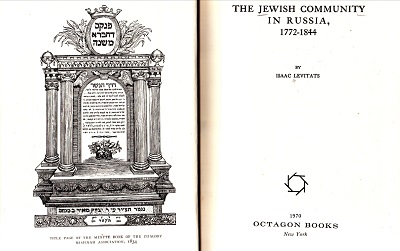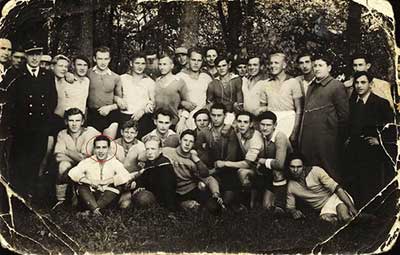Jewish Žagarė
Žagarė (Zhager in Yiddish) had one of the oldest Jewish communities in Lithuania. There was a continuous Jewish presence in Žagarė from at least the16th century until October 1941. In its heyday Zhager was known as a city of Torah and wisdom; it produced famous scholars, writers, and rabbis. Chachmei Zhager they were called: the wise men of Zhager. As Josef Rosin notes, while quite a small town Zhager "produced a long line of erudite men, intellectuals, writers, researchers and public figures who were well know in the Jewish world."
Size of Jewish Community
For much of its history, the Jewish community comprised a
very significant share of Žagarė's total population. In 1766,
840 Jews lived in Žagarė. The Jewish population grew to over
2,200 in 1847, and to approximately 5,500 in 1897 when they
constituted 60 percent of Žagarė's total population. By1923,
at the tail end of the brief Golden Age of Lithuanian
independence, there were about 2,000 Jews in Žagarė, 40
percent of the overall population. By the beginning of World
War II the number of Jews declined to about 1,000; most were
shopkeepers, artisans, or vegetable gardeners. Today there are
approximately 3,000 people in Žagarė; the only surviving
Jew, Isaac Mendelson, died in 2011.
Early Economic Activity
The size of the Jewish population depended, in part, on economic conditions and, in turn, the Jewish community played a major role in Žagarė's economic growth and development. By the 17th Century Jews were engaged in significant commerce. They imported salt and metals, and exported flax, grain, honey, and wax. Also, the Jews had leased the right to charge import duty from the government. Their occupations ranged from artisans to tax farmers.
By the end of the 18th century (1790) Žagarė's market place was exclusively inhabited by about 50 Jewish families, who owned 30 shops and taverns in and around the town. Jews exported linen, grain, and wheat to Germany. In the early nineteenth century, the number of market days and fairs was increased upon request of the local Jews and in 1803 the market area was paved. Jews set up factories for processing bristles, candles, mead, wire, and hides; they did a brisk trade in flax, grains, metal, wines, and machines. Prior to World War I, Žagarė grew and its economy expanded due in large part to the hard work and initiative of the Jews.
Old and New Zhager
From the earliest days of Jewish life in Žagarė there were
Jewish buildings and institutions, such as a synagogue and a
beit midrash (place dedicated to Torah and Talmud study). The
first autonomous institution in Žagarė was the Jewish Kehillah
, a quasi-governmental authority that dealt with both the
Jewish community and its relationship with the gentile
community. The Jewish beit din (court) was the first law court
in the area. Over the years many structures and organizations
were established: several prayer houses, including synagogues
and beit midrashes, ritual baths, cheders (religious school
for young boys), a Talmud Torah school (similar to a cheder),
yeshivas (religious seminaries for older students), girls
schools, a yavneh (religious Zionist school), among others.
 |
| Title page of the Minute Book of the Zhager Mishnah
Association, 1834. Source: "The Jewish Community in Russia, 1772-1844", by Isaac Levitats, Columbia University Press, 1943. |
There were also many charitable institutions, including a home for the aged, Bikur Holim. There was a Jewish Peoples Bank. Cultural and intellectual life developed. For many years there was a large library and a bookshop in the town, with an emphasis on Yiddish and Hebrew literature. There were Jewish evening classes, Jewish sports clubs, and even a Jewish fire brigade.
 |
| Football team |
Political and social movements were well represented in Zhager. There were Jewish youth, Zionist, and political movements, often with friction between parties and the various Zionist groups. There was a knowledgeable Jewish working class element which, through its organizations, especially the "Bund", had influence on Jewish life in the town. Zionism developed strong organizational influences in the early 1880's when some of the first Zionist groups were established in Eastern European countries with the aim to promote Jewish immigration to the Land of Israel. Zhagerites played a significant role in the Kattowitz Conference where thirty-six delegates met in 1884 and formally established an organization named Hovevei (Lovers of) Zion. The Agudah (or World Jewish Union) was also active in Zhager. There were many Zhagarite donors to the Agudah fund. The Agudah was established in the early twentieth century as the political arm of a religious movement with its base in Eastern Europe. Prior to World War II it operated a number of Jewish educational institutions throughout Europe.
During the Soviet annexation of Lithuania (1940-41) all Jewish institutions and organizations were disbanded. The Yiddish library was one of the few organizations that continued to function in these years.
As the overall Žagarė community was divided by the Shveta River into Old and New Žagarė, so was the Jewish community divided into Old and New Zhager. Each side of the river had its own community with its own rabbis, shochets (religious slaughterers), cantors, and even separate cemeteries. They also had separate quarrels over interpreting the Law and separate discussions about whom to call for an aliyah (blessing over the Torah) or whom to choose as gabbai (head or treasurer of the synagogue), and over other maters. New Zhager was more modern and well-to-do with better living conditions and nicer buildings, most of which were of 2 stories. New Zhagerers used to jokingly refer to the other side as the "Old Zhagerer corpses" as a sign of their poverty, negligence, and lack of vitality.
The gulf between New Žagarė and Old Žagarė continued to
divide the two populations until the years between World War I
and II. The rift was finally healed by the good offices of
Rabbi Israel Reif, Rabbi of New Žagarė and his son Rabbi
Yitzhak Zondel Reif, who led the congregation of Old Žagarė.
One writer credits the healing of the rift to economic bad
times after World War I: "Recently the terrible economic
situation has joined the two parts and made them into a single
shtetl in every respect" since the New Zhagerers no longer
looked down on Old Zhager "since now the same lack of vitality
rules in New Zhager as well."
Relationship to "Majority" Community
The relationship between the Jewish community and the "majority" Lithuanian community depended on many factors, but economic conditions and outside political and historical trends were probably most important.
It has been said that Jews and Lithuanians lived in harmony for many years and, in fact, for much of Žagarė's history Jews and gentiles functioned reasonably well together in a shared economy. Towards the end of the 19th Century relations between the Jews and the authorities improved as a result of the community's growing prosperity. By the early 20th Century, Jews identified themselves with Lithuania's struggle to free themselves from Tsarist oppression and to establish their long-suppressed cultural identity. Žagarė's Jews demonstrated strong solidarity with their Lithuanian neighbors. For example, when the Tsarist authorities banned the publication of Lithuanian language books, local Jews helped to smuggle Lithuanian literature from abroad into the country.
Nevertheless, in many ways the Jewish and gentile communities were separate. As was typical in European history, Jews often performed functions that Christians were not permitted to. For example, under Russian rule Christian peasants were not allowed to deal in alcohol; this resulted in a Jewish monopoly of establishments producing and selling alcohol. At times this led to friction when over-consumption became a problem. Jews complained at times, such as the interwar years when Lithuanian nationalism was at its height, that Lithuanian businessmen would come to town to agitate with their "Lithuania for Lithuanians" propaganda. It is noteworthy that this was during a period of economic depression. It is also interesting to note that Jewish writers never refer to themselves in "hyphenated" terms, such as Jewish-Lithuanians, but rather refer to the majority community as "Lithuanians" and themselves as Jews or "Litvaks" (which means Jews who speak a "Lithuanian" dialect of Yiddish).
Introduction
History
- History by compiler
- - Historic Events
- - Emigration & Extermination
- - Noteworthy Natives & Descendants
- - References
- Others' Histories
- Rose Zwi's story
- Historic photographs

